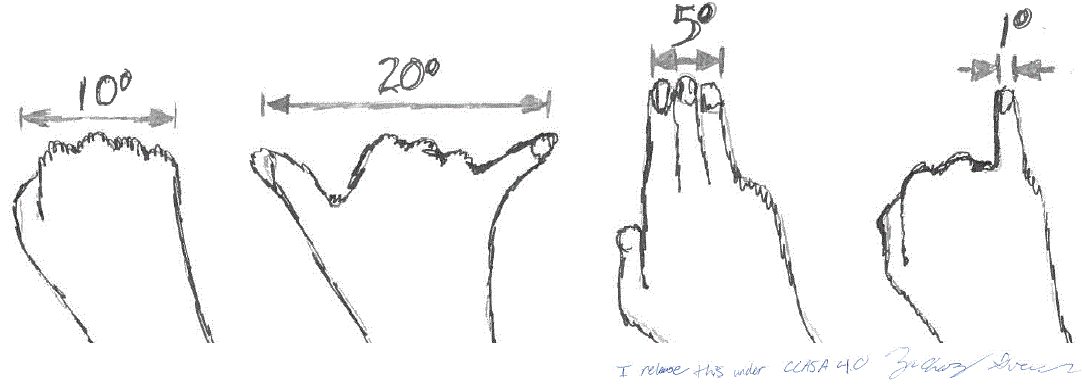Imagine a car or truck speeding away in front of you on the road. Here is a rough method to estimate its distance and speed using your outstretched hand (try this as a passenger, not a driver!).
At any given time its distance away is approximately
We use the figure below to estimate angles based on our outstretched hand at arm’s length:

Hence a vehicle that is 2m wide subtending an angle of 5 degrees (3 fingers at arm’s length) is about 23m away. At 1 degree (1 little finger at arm’s length) it is about 115m away.
Then measure the time T (in seconds) it takes to go from 3 fingers width (5 degrees) to 1 little finger width (1 degree) at arm’s length. Its relative speed in km/h is approximately given by
For example, if a 2m-wide car takes 33 seconds to go from 3 fingers to 1 little finger width at arm’s length (115-23=92 m in distance), it is going 10km/h faster than I am.
To justify these formulas, the figure below shows segment BC of width w at distance d from A, subtending an angle of . Using trigonometry we find
. For small angles,
where
is measured in radians, an approximation that is only around 1% inaccurate even when
is as large as 20 degrees.
Formula (1) then follows from and the fact that angles
in radians are
times angles
in degrees.
Formula (2) is true since we are covering a distance in time T. Multiplying this by 3.6 to convert from m/s to km/h gives us the approximate scale factor of 165.
The table below shows some sample values for a car with width 2m and truck with width 3m.
| Angle subtended by object (degrees) | Width of vehicle (m) | Distance of object (m) | Approximate distance using (1) |
| 20 | 2 | 5.7 | 5.7 |
| 10 | 2 | 11 | 11 |
| 5 | 2 | 23 | 23 |
| 1 | 2 | 115 | 114 |
| 0.02 | 2 | 5730 | 5700 |
| 20 | 3 | 8.5 | 8.6 |
| 10 | 3 | 17 | 17 |
| 5 | 3 | 34 | 34 |
| 1 | 3 | 172 | 171 |
| 0.02 | 3 | 8600 | 8550 |
The smallest angle of 0.02° (~1 minute) approximately corresponds to the smallest object we can resolve with the naked eye.
The next table shows estimates of receding speeds based on going from 5° to 1° of angular diameter.
| Width of vehicle (m) | Time (s) to go from 5° to 1° | Estimated speed (km/h) |
| 2 | 3 | 110 |
| 2 | 5 | 66 |
| 2 | 10 | 33 |
| 2 | 33 | 10 |
| 3 | 5 | 99 |
| 3 | 10 | 50 |
| 3 | 33 | 15 |
Reference:
